Dave Strohmaier and Randy Gitsch - in conversation with Mark Lyndon | Read more at in70mm.com The 70mm Newsletter |
| Written by: Mark Lyndon. Monday 30 April 2012. Retyped from audio files by Margaret Weedon. Completed 26 June 2012 | Date: 12.07.2012 |
Cinerama | |
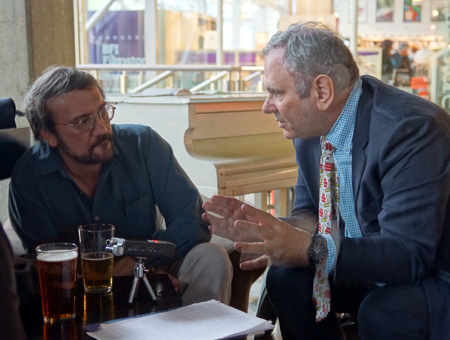 Strohmaier
and Lyndon. Image by
Tom March Strohmaier
and Lyndon. Image by
Tom MarchML: Who killed Cinerama? Who were the main suspects? DS: Corporate America, killed it - in a way: RG: Greed killed it - plain and simple – it cost more than three times the money to shoot; it took five projectionists just to show it: DS: You had a couple of different companies going on, there was Cinerama Inc., that created the equipment, the Fred Waller part; you had Thomas-Todd Productions and/or Stanley Warner Theaters, which took another chunk, and then you had the theater which had to keep a certain amount and, of course, they had their larger staff; the five projectionists like Randy said, and the extra ushers; in those days you had an usher to seat people, a couple of people as greeters, the ticket person, a limited amount of concessions: RG: huge overheads. DS: Every ticket sold had to be divided into these sections and then the money taken to whoever owned that particular part of it. RG: In addition to which there were some (and we do not really know the bottom of the story) legacy payments from the early days – start up money; money that was pulled in early on; they had to pay all these people off. This leads to the notion that there were more than 100 per cent investors - perhaps 200 per cent investors. DS: Some of those were bought out early before the success - such as the Rockefellers. I do not know what they put in – it could have been $50,000 to $100,000; might have been more, but they were bought out by Hazard Reeves for $1600; just to get a piece of paper signed that says - “We own it”. ML: There were investors who pulled out at the very last moment with cold feet? DS: Yes, and then suddenly within a year or two years it was called a gold mine, and that is when it went public, and people would buy stock. ML: Why did they not invest in research and development? For the camera; a new camera; vista vision? DS: They invested in a new camera after “This is Cinerama” came out – the new camera was the one we use on the film we are shooting now. ML: I do not mean that one - there was another one, with a single lens. DS: That was later; there was an oil based lens that you could record on a curved aperture plate inside the camera that was 12 perf. Just one strip; they were always going to keep three-panel in the theaters; there was always going to be three projectors, and one salaried producer. But this optical, i.e. recording it on a flat field, a curved flat field, would allow you to go back to six perf. in an optical printer. So the theaters were going to stay the same, but the camera was going to be different. RG: They also spent Research & Development money to get over some of their problems - R&D money that the Smith-Dietrich Company might have earned, but Cinerama didn't pay Smith-Dietrich for their findings. I guess they had a cash shortfall when the bill came due. And apparently, in an odd moment of amazing stupidity, they did not have a contractual clause that prevented Smith-Dietrich from selling that research to anyone else; so along came National Theaters and bought basically off the shelf the Cinemiracle technology which Smith-Dietrich had created at the request of Cinerama originally. | More in 70mm reading: in70mm.com's Cinerama page Cinerama Adventure "Windjammer" Press Release The 2015 European Cinerama Festival Tour Scanning Cinerama Films Dave Strohmaier Randy Gitsch "Keepers of the Frame" Internet link: David Strohmaier |
The Camera | |
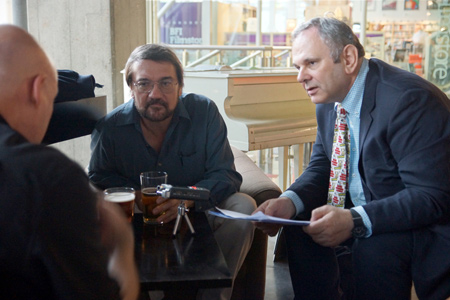 Gitsch,
Strohmaier and Lyndon. Image by Tom March Gitsch,
Strohmaier and Lyndon. Image by Tom MarchML: Was it Dick Babbish who took out a patent on the original camera? DS: He is listed with Fred Waller on the original camera number one; then they went on to develop cameras two, three, four, five, six, and seven, which was an improvement on camera number one, even though different alignments; that is why you have to do different alignments between “How the West was Won” and “This Is Cinerama”, because it is two separate types of cameras. ML: Then he designed the Cinemiracle camera to evade his own patent. DS/RG: yes, that is right; who would know better than the best guy on the planet how to get around the patent? ML: Now there are only two guys on this planet who actually know, I believe, what it is like to direct a genuine Cinerama film - (DS: “I wonder who that can be” – ML: “well, yes”), but what are the highs, what are the lows, what are the ups what are the downs; what are the heart aches, what are the joys – thinking “Oh god that is so good - I have actually done something totally historical!” ? DS: more of the previous than the latter. ML: So it is 99 per cent misery and one per cent joy? | |
The Pitfalls | |
 Mark
Lyndon. Image by Tom March Mark
Lyndon. Image by Tom MarchDS: Pretty much - but people are having fun doing it – talking about the present shoot; and they are actually being paid amazingly enough but very, very little; sort of expenses in a way, but they are so sad that we are almost done. We have got a second unit day to shoot, and that is it. But the problem with it is you cannot hear the actors act; you cannot see if they are hitting their marks; you have to stand behind the camera and, although there is a view finder, you can only see one panel at a time. RG: You have to approximate. DS: So, if everybody walks into a scene, they are going to talk, then they walk out an exit; you cannot see if they have hit their marks until you see the dailies. And if they miss their mark does it ruin the shot? No, you have to use the damn shot because you cannot go back to the location (because you have to buy another permit, and you have got to pay everyone to come out at 6 o’clock in the morning, and get set up): ML: A total nightmare. RG: You cannot see lens flare. It may be only on one panel but you will not know that until you get your dailies back; because you do not have a reflex view finder. ML: There is an Australian gentleman who I believe has a camera and process called Kinopanorama: DS: Well he probably has a better view finder. I have seen his footage and it is OK, but he is under a lot of restrictions too; lugging something big around, and stuff. We try to get as many action shots as we can but we actually wrote a script that we are filming. And so you have to be creative with that because it has got restrictions; and so maybe we ought to dolly here, because we are walking, and we need to keep the camera moving, and you cannot always do that: but then you know that that is another set up, everyone has got to hit their marks, and so on, - “So, can we make it by 3 o’clock? – no, we can’t! – all right, static shot!" ML: “the light is going” - (as David Lean used to say). DS: We have got that situation now – this thing should have been shot and edited by last November. But we had so many problems getting started and the camera guy repairing the camera, that we did not start shooting until January – way late – so that is why I am doing two projects at once – restoration and shooting, and then editing the shooting project. | |
Post Production | |
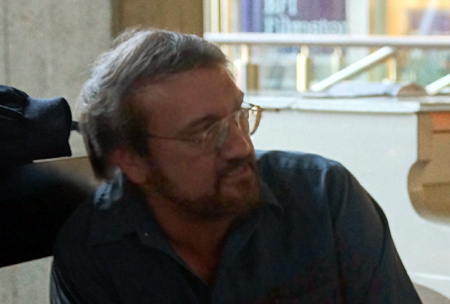 Dave
Strohmaier. Image by Tom March Dave
Strohmaier. Image by Tom MarchML: When would you go into post production, what would that entail? DS: You have to invent things because there is no way to do it the way they did it - even although the end result has to be the same. And you cannot record sound; we record it on the set (similar to what you are doing here) - but it is a scratch track because the camera has gone ‘fluttering’ and the planes are flying over , and so you get the lines in their mouths and then you replace it all later, which is a huge process because there are a lot of lines; then you have to edit it together; it is 26 frames per second that has to translate to 24 - so you have to take the movie, all your dailies, everything from day one on through, with the sound sync up on a separate track. You set up a high definition camera – the Cinerama dome - and you record over the dailies; each one of the dailies has a scene code, which is inscribed with number one - first four frames there is a clapper – four frames later you will see a four, four, four, four, four. And the screen will go four – and it is on each panel; so I know which take it is of a particular shot. ML: These are the sync shots? DS: No. This is actually scribed with a pin and a number 4 on four of the frames, and it is an animated four when you record it from your video camera; so you know exactly where you are in that daily, but digitally. Now you edit a rough cut, digitally, so you get your story and you know which actual takes you are using, which actual lines of dialog that you have got to replace. DS: It is huge. No one has ever done this before; we had to invent it to figure it out. A plan had to be laid out as to how this process is going to work. Several people would argue with me – experts in sound, experts in picture – saying you cannot do that, and then I did it at the test and it worked. So now I am thinking of ways to improve it! ML: You have to actually do it - DS: yes ML: So you are re-writing the book – all together - DS: post production wise, yes. ML: All this will be seventeen minutes long? DS: fifteen to eighteen, who knows; if it is slow we might want to drop a scene. John Sittig of Cinerama calls it his Heavensgate. RG: Shovel more money in. [ML: dare I ask how big the budget is? – DS: you cannot repeat this, but it is $ *****!] ML: So for a Hollywood blockbuster ... – DS: It is not going to be a blockbuster, and I hope people do not have expectations of it being the most beautiful Cinerama film ever made; this is an experiment. It is meant as a lark – but it is going to be clever and intricate in a certain way; and some people may fall asleep through it, other people may be glued to it. You never know. ML: I must say what was very, very impressive was the yacht; better than “Windjammer”! DS: That was probably only about four minutes of the whole movie; we did not show you all of it. RG: I expect there will be people who will call that hommage to “Windjammer”, and in our heads it is, because we did so much restoring, remastering and roadshowing “Windjammer” in the last three years. | |
Making a Success | |
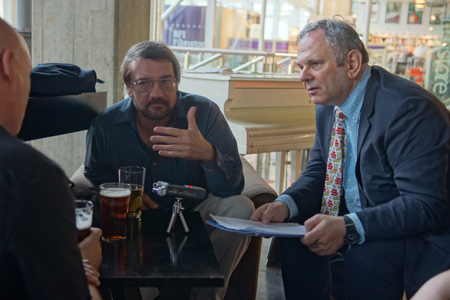 Gitsch,
Strohmaier and Lyndon. Image by Tom
March Gitsch,
Strohmaier and Lyndon. Image by Tom
MarchRG: The film will succeed probably because it has nothing to compare itself to; it is a promotional film and promotional films are never supposed to bring you down; they are supposed to bring you up, so it does do that, and you will only be able to see it in Cinerama; it will be special - it will be nice, and it will be promotional; it will be light, but most of all, you will be seeing it in Cinerama. The people who will see it will thoroughly appreciate it for that reason. DS: In theory, yes, otherwise they may say – “Why did they not move the camera more” – “well you were not with us helping us to move it” – “it was 3 o’clock, the sun was going down and we had to get the shot!!” ML: They have never actually suffered the tortures of making these things so cannot possibly understand that it is three times more painful than a normal shoot. DS: The first day of the shoot we got the dailies back; we said “we are going to use it – we cannot afford not to” – and there was a hair in the gate! We said “OK well that happened in the travelogues – you will see it”; so all my camera guys said we have got to reshoot that: I said “No we are not”! – ML: – perhaps our hommage to "TIC" and Waller’s water-ski-ing!! | |
Rich Backers | |
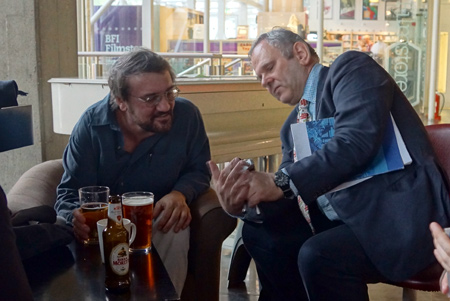 Strohmaier
and Lyndon. Image by Tom March Strohmaier
and Lyndon. Image by Tom MarchML: Could it be remotely possible that there will be an eccentric billionaire software inventor (I am not naming anyone ...) in the audience, and he says – “just think if you can make a feature” and he could give you a budget that would be more than adequate – it would not be a "Cleopatra" necessarily, but would you actually consider? DS: that was discussed at one point. RG: We had a brush with a software millionaire who was capable of fulfilling this scenario you are proposing, but they did not! ML: When he sees that sequence with the yacht – seeing is believing - and he might say “that is it” - and the money will be in your bank! DS: Well anything can happen but my theory is that when they call me up – and they call me up every couple of years - they want to ask some questions, and I give them the answers, but my next conversation with them is :- “Do not bother me until you are serious because this is the third time, and I am a little too busy for this guys, and so you call me when you are really ready to go”. (I can say that to them because I am not on their payroll. I am the one guy that they cannot control!) | |
Pacific Theatres | |
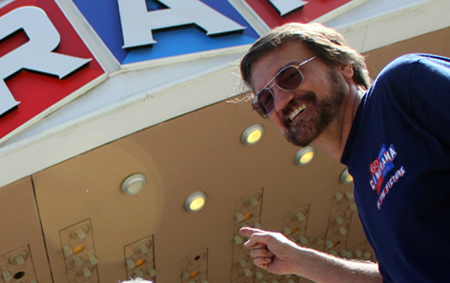 Dave
Strohmaier outside the Dome in Los Angeles. Image
by Robert Garren Dave
Strohmaier outside the Dome in Los Angeles. Image
by Robert GarrenML: Our Danish colleagues (who must remain anonymous!) would like to know how you turned Pacific Theaters around, and persuaded them to dig negatives out of the vaults, to install three-strip at the Dome, and to film brand new material for the Cinerama Diamond Jubilee this year – how did you actually manage to talk them into it? DS: Well that is the one thing that the billionaire did help us with because they started the ball rolling - if somebody else gets interested then he must be interested, i.e. “he must know something I don’t! “. Then John Sittig went to the head of the family that owns all this stuff – (it is a family owned organisation) – and said we really need to do something now- (we had been bothering them over the years, not consistently, but a little note here and there) – and I went to a meeting four years ago and told them all their film is rotting; I said – “if you do not do something about it now you are not going to have an asset”: I knew how much they were paying for storage, I told them – “you are paying $30,000 a year down the drain” – “you are storing film that is rotting – either get rid of it or do something with it”. DS: Then that takes a year to gel in their brains and you have to remind them. Then John finally went to it, after the billionaire thing, things started to happen. John got a grant to do a certain amount of stuff, and it was my job to take that grant money and make it all work. I never was good at accounting – (I can balance my cheque book) - and now I am handling all this money, and making sure that we come in on budget; right now we are over budget by $6,000, which is not bad when you think of the huge project: RG: That is an hommage to Cinerama – to go even a penny over budget - because they did go over budget; but I was going to say that there were other little things that helped us and helped the restoration movement. About four years ago Michael Foreman saw a screening of “How the West was Won”, with his friends. Now you have to think as the son of the guy who owns Cinerama, how many times did Michael Foreman grow up seeing Cinerama? This was not his first time seeing “How the West was Won” but this time he saw it with some friends, and his friends loved it! Suddenly he is the man of the moment. DS: The next thing we knew Michael Foreman is interested in his assets; thus we went to a meeting with the billionaire; (this is subject to confidentiality agreements); they decided not to do it, but we went armed with the grant and we were telling Mr Billionaire we have got some money to add to your efforts, etc., figuring that would jump start everything, but it did not impress anybody. DS: But when that went south we were left with the grant money; so John Sittig said to me “what can we do with all this money” – “how far can we go with this money?” I went home, and in three days did various types of budget all of them way above, until I finally worked out what we could do. Then the last thing to add was, should we shoot anything with the camera; I knew what it was going to cost to fix it – it was a flat fee. We did not have to actually rebuild it; these things are made so well; like a ‘57 Buick that has been kept in mint condition, put some oil on it !! Whatever electronics you need for the automatic starter - whatever the starters are – they are fancier now! ML: – The camera can perform – and you have got Fuji film? | |
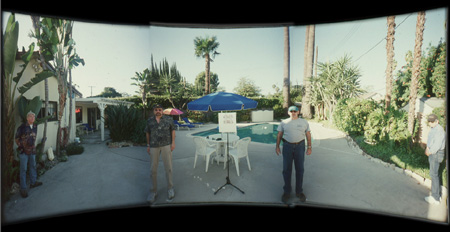 Smile
Boxed Cinerama test footage 02.11.2011. Back yard people test-blended. Smile
Boxed Cinerama test footage 02.11.2011. Back yard people test-blended.
DS: We found the camera man, and the maintenance manuals, because of the man who helped invent it with Dick Babbish had a filing cabinet in his garage that still had all this stuff; so I was able to train the cameramen with all the intricacies – a whole different way of focussing, which drove everyone nuts because it is not the normal thing, and so we had to do some experiments. We shot all sorts of things in my driveway. I showed you some of the films. We had to make mistakes in order to know where the limitations were. We did all that – Fuji provided that film for free – Fotokem provided all the processing for free; and then, when we started production, it was these huge discounts, just because we were their pet project; and so that is how that came about. In reality the restoration is where all of the money really should have gone but this side thing John wanted to do. | |
Smilebox | |
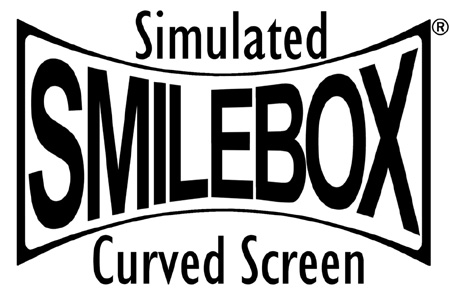 ML: One last question really – Smilebox is a wonderful thing. What sort of
future is there for Smilebox? My dream would be if I could get myself a high
definition camera and stick on a lens, approximately 146 degrees; it is what
Paul
Samuels did: ML: One last question really – Smilebox is a wonderful thing. What sort of
future is there for Smilebox? My dream would be if I could get myself a high
definition camera and stick on a lens, approximately 146 degrees; it is what
Paul
Samuels did:DS: Yes he did something like that: ML: Do it in his blessed memory: and then process it through Smilebox. You said it was good for a curved or a flat screen. DS: Amazingly it works on both. ML: Would something like that work for a home enthusiast? DS: As far as shooting something, I do not know. I am not sure what kind of lens you would need to do that. The best thing you can do is to shoot a super wide angled lens somehow, and then do your own Smilebox in some kind of a programme; and then fit it on your particular screen. RG: I am not sure, but I guess you can ponder, what is the point in putting theatrical motion pictures in a Smilebox simulated curved screen view. Why are you doing it? Cinerama was done because it’s three, adjacent, wide-angle lenses, captured images which when projected as a composite on a curved screen become three dimensional. In addition to which, Cinerama always included aerial photography; and it was a new, out of the box visual attraction for 1952. Aerial photography isn't new, or novel anymore; if you look at current installations, theme park installations of aerial photography - like Soarin’ (Over California) at Disney's California Adventure park, it is not just curving to the sides around you, as Smilebox would. It is really Fred Waller‘s original Vitarama concept; it curves over you and under you - it is around all peripheral sides of you. To go in that extreme direction you need more than just Smilebox. If talking about theatrical motion pictures, Smilebox is best applied to anything archival that was ever shown on a laterally curved screen: D-150, certain Scope pictures; anything that was ever shown theatrically on a curve; it need not have been a Cinerama film. DS: And we do different Smilebox: “Windjammer” is a different Smilebox ratio to “This is Cinerama” because “Windjammer” originally premiered at less of a curve. ML: at 120º? DS: yes, we did less of a curve for “Windjammer” than we did for “This is Cinerama”. | |
The Curved Screen | |
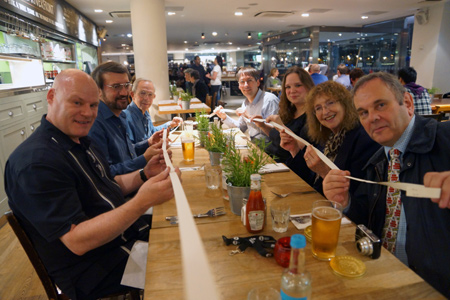 Randy
Gitsch, Dave Strohmaier, Loren Janes, Clemens and Melanie Sherer,
Margaret Weedon and Mark Lyndon. Image by Tom March Randy
Gitsch, Dave Strohmaier, Loren Janes, Clemens and Melanie Sherer,
Margaret Weedon and Mark Lyndon. Image by Tom MarchML: So what do we have left now in the world? We have the Pictureville in Bradford, the Cinerama Dome in LA, Schauburg in Karlsruhe, the Royal in Malmo, and the Imperial Bio in Copenhagen with curved screens. RG: I'd even add the Hollywood in Portland. ML: Your programme at the Dome should get you a lot of publicity, hopefully, and it will be a pilgrimage from all over the world – yours will be the definitive Diamond Jubilee celebration: DS: You cannot get that in Seattle because they do not know how to do it. ML: Is it that they have to assemble the thing, and they have a problem? DS: They just do not have any concept of what showmanship is; for instance - the orchestra would be playing, and they have the curtain completely open! - they say “well, what is wrong with that”?! DS: I have to tell them, I wish you would stop running Cinerama because I get emails all day long about how lousy you guys are doing it - so please do me a favour and stop running Cinerama. RG: I just got an email from a theater manager two weeks ago saying that they would be remiss to screen any of our Smilebox features on their flat screen. They shouldn't be, because Smilebox allows you to screen these new digitized versions on a flat screen, or on a curved screen, with excellent Pictureville-approved results. RG: So there are some theater managers and programmers who, perhaps, just don't get it right now - but they'll get it very soon, and likely sell a lot of popcorn once they do. DS: I got an email from the distributor this morning – it says that they are getting complaints from one person who says that all of his friends refuse to buy “This is Cinerama” and “Windjammer” because it is in Smilebox!! RG: They think it should be Letterboxed; - “Because that is what the filmmaker intended" - so they think - but that is not what the film maker intended. The Cinerama films were never seen Letterboxed - ever – no one has ever seen them Letterboxed, and it would be wrong for audiences to see them that way now. DS: I have to write an explanation so that this guy can send a letter to the character and say, basically, the same thing – “no one ever saw this other than in this format, i.e. Smilebox”. RG: Now we are not talking about Smilebox, we are talking about a curved screen here; no one ever saw “South Seas Adventure” unless it was on a curved screen, and so we are honouring the film makers who struggled to make this movie, so do not put it in Letterbox. | |
The Correct Format | |
 2011
crew shot (L to R): Tony Saenz (Production Manager/Producer), Lance
Fisher (Camera Operator), Doug Knapp (Assistant Director of
Photography/Camera Operator), John Hora (Director of Photography), Dave
Strohmaier Director/Grip, David Tondeur (Camera Operator), Ken Stone
(restored the camera, he can fix anything) 2011
crew shot (L to R): Tony Saenz (Production Manager/Producer), Lance
Fisher (Camera Operator), Doug Knapp (Assistant Director of
Photography/Camera Operator), John Hora (Director of Photography), Dave
Strohmaier Director/Grip, David Tondeur (Camera Operator), Ken Stone
(restored the camera, he can fix anything)RG: It is not only us who respect this way of thinking, that you honor the film to be seen in the manner in which it was originally intended, but there is a whole movement in Hollywood - and universally too – extolled by the Artists Rights Foundation – it advocates the notion that you do not mess with another film maker’s work. You do not suddenly ‘Scop-e-tize’ a film maker’s 1:33 work; you do not ‘colorize’ “Citizen Kane” just because you can! You really should honour the way the film was originally exhibited and what it really truly looked like; and if it was not Letterboxed it never looked that way. That is why at the beginning of the DVD you will see the following announcement – “You are about to see the Smilebox version the way millions of people originally saw this film, etc.,“ (“so you want to argue with us - you want Letterbox”?!) They may say, “well, I have got a curved screen at home”, but that is not a problem if you have a 146 degree curved screen, and you run Smilebox on its own aperture plate, it completely gives you exactly what you want; home enthusiast Brian Allsopp also has done it; Tom March has done it in his house. It fits. You may have to adjust your masking a little bit if you have keystone or whatever. DS: When we do Smilebox for Bradford we have to make a separate Smilebox because they are slightly off centre; so the curvature is bigger at the bottom than at the top (which drove me crazy because they were not giving me the specs until the last minute) – it was tricky. Now we have it – if we do it next year – they had better not move that projector over to the other side - or make it up higher! ML: In Bradford, maybe they overdid the ‘Obit’ section but, as a keeper of the Cinerama flame, and member of the Cinerama family, it was right to honour Paul Samuels. DS: I kind of agree – for Paul Samuels, and the people who were involved, we definitely had to do something; a little support. We were all upset when we got the news. ML: so here is to his blessed memory – Cheers! – he used to enjoy English beer. DS: He used to come to my back yard barbeque every year; and we would show a little something on the screen; last year he was with me - we had about 20 people in the yard – Paul Rayton was there, every once in a while Duncan is there. Paul said “I hear there is a rumour that you are going to run the new “This is Cinerama””. I said “No – we have not thrown the steaks on yet”! RG: The last time we were in Bradford – before this (2012) trip – Dave and I and Paul went up to tour Skipton Castle in the rain and we were taking pictures; etc.. We had to duck inside a couple of pubs to dry off because we were getting pelted with rain; I felt sorry for Paul who did not have an all-weather bag for his camera. | |
BFI Screening of “This is Cinerama” | |
 Dave
Strohmaier and Randy Gitsch outside the BFI in London. Image by Tom March Dave
Strohmaier and Randy Gitsch outside the BFI in London. Image by Tom MarchML: -How did the audience react to the BFI screening of “This is Cinerama”? RG: There were two reactions; I introduced the film and sat with the audience up until and through the rollercoaster sequence. I noticed that the audience included grey-hair and when I first asked “Who was there on opening night, for the premiere of "This is Cinerama?” - we had eight or nine of those people put their hands up. And you could tell from the look on their faces, they were going to relive a thrill they'd not experienced in 50 plus years. For example, there was a couple there – their first date was opening night - they were sitting in the back row tonight – they made a joke that this was their second date! But a large part of the audience were in their teens, twenties maybe early thirties; those people were tittering at kind of the old hammy-ness as well as the coaster effect. They enjoyed Lowell Thomas – the time capsule stuff he was saying; so I think the film has that retro appeal. It is old glory, and it is new camp, and a nostalgic but still effective thrill ride. ML: How would it have played in the London Imax? DS: It would not look that good in there – it is only 2K; shame they did not show it in the NFT1. (Act One in Bradford was out of focus). | |
The Future of Cinerama | |
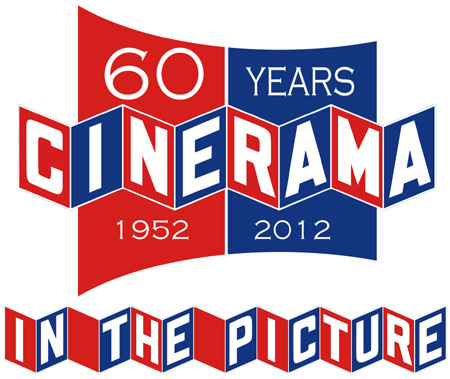 ML: To sum up - What is the future of Cinerama? ML: To sum up - What is the future of Cinerama? DS: Other than they will all be re-mastered including the 70mm, which are done, and they will be used for limited theatrical and maybe DVD, it all depends on the sales of these, and if that same distributor does not want to do these because everyone is demanding Letterbox - then another distributor we know might kick in and do it; but still you have four complete titles. The manufacturing costs for four complete titles for Blu-ray can vary anywhere between $25,000 and $33,000 and that is for 3500 units. It is cheaper after that. ML: Flicker Alley: they said decisions about releasing the rest of the travelogues are based on the sales of the first two: DS: I think they are going to wait and see – see what the sales do. RG: They will do a wait and see what are the sales of the first two titles, and any other distributor who ended up second in line getting the licence for “This is Cinerama” and “Windjammer” may suddenly be more vocal coming after the other titles - based on the performance of the first two. RG: Ultimately, the audience will decide. | |
A Closing Timeframe? | |
|
Clemens: (visiting from Karlsruhe): Do you guys think you are using a time
frame that is slowly closing? We are now doing this Cinerama short because
perhaps in ten years - when there are no more investors – it will become
impossible? DS: Yes, you will not be able to do anything; that is why we are sure this is the last time the camera will be ever be used; but somebody probably said that in 1961 - nothing will ever happen! RG: To get back to your question, Cinerama’s future might evolve into a name on more than just a couple of theaters; Cinerama could come to mean a curved screen presentation; a noticeable distinct curved screen, perhaps not 146 degrees, but certainly more than a marginal curved screen you see merely as a design feature – just as an afterthought - but in a lot of new cinemas in the US; I am talking about a screen that might just be more curved. ML: at least 120 degrees? |
|
Gourmet Cinema | |
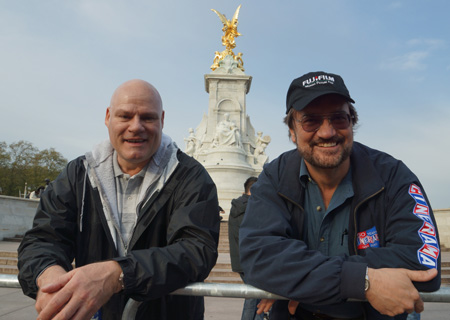 Randy
Gitsch and Dave Strohmaier. Image by Tom March Randy
Gitsch and Dave Strohmaier. Image by Tom MarchRG: Perhaps. It could come to represent that, and showmen could use it as they did for years as a marketing tool for a wide screen premium experience – you see a lot of that trend in motion picture theater marketing these days. Theater owners want to get people to join a club now; reserve their seats ahead of the show; get refreshments - better than just some stale popcorn and a soft drink; come and enjoy a knockwurst in a baguette – have a glass of wine ... and enjoy a movie on our premium curved Cinerama screen. This could bring showmanship back to movie theaters. ML: Gourmet Cinema? DS: Yes, exactly - it could be marketed in that manner! ML: Thank you very much - it’s a wrap. | |
| Go: back - top - back issues - news index Updated 22-01-25 |
